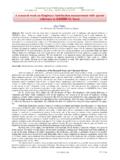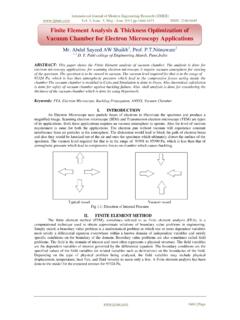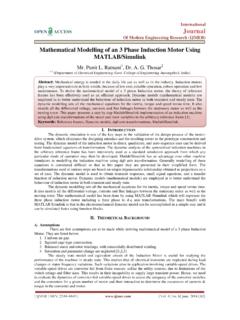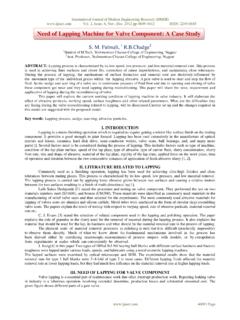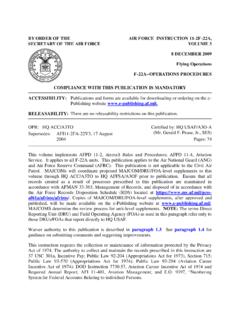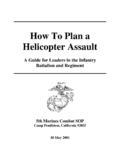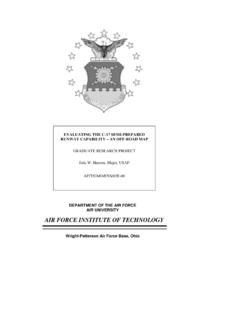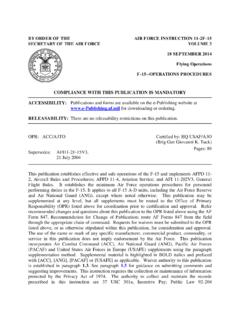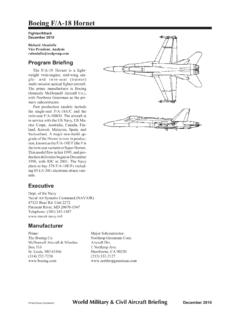Transcription of Experimental Study of Full Authority Digital Engine ...
1 International Journal of Modern Engineering Research (IJMER) Vol. 3, Issue. 6, Nov - Dec. 2013 pp-3591-3603 ISSN: 2249-6645 3591 | Page Md. Akhtar khan1, Md. Muqthar ghori2, Syed Abdul Khaliqh3, Md. Mohsin Ali4 ABSTRACT: full Authority Digital Engine control (FADEC) is a system consisting of Digital computer, called an electronic Engine controller (EEC) or Engine control unit (ECU), and its related accessories that control all aspects of aircraft Engine performance. FADECs have been produced for both piston engines and jet engines. FADEC consist of HMU, Sensor and EEC.
2 The proposed single chip SOC ASIC device integrates many diverse and improved functions required for interfacing with most types of FADEC Control sensors and actuators. FADEC or to expand the capabilities of a legacy FADEC system by addinga sensor or actuator. The same Smart Nodes can be applied without hardware change for controlling actuators, interfacing with sensors or a combination providing an affordable, scalable and reusable solution for Commercial and military engines, small or large, missiles and UAVs. True full Authority Digital Engine controls have no form of manual override available, placing full Authority over the operating parameters of the Engine in the hands of the computer.
3 If a total FADEC failure occurs, the Engine fails. If the Engine is controlled digitally and electronically but allows for manual override, it is considered solely an EEC or ECU. An EEC, though a component of a FADEC, is not by itself FADEC. When standing alone, the EEC makes all of the decisions until the pilot wishes to intervene. Keywords: FADEC, UAVs, Lycoming Engine , sensor, Ignition system, BPMS, Electrical system I. INTRODUCTION The UAV is an acronym for Unmanned Aerial Vehicle, which is an aircraft with no pilot on board. UAVs can be remote controlled aircraft ( flown by a pilot at a ground control station) or can fly autonomously based on pre-programmed flight plans or more complex dynamic automation systems.
4 UAVs are currently used for a number of missions, including reconnaissance and attack roles. UAV is defined as being capable of controlled, sustained level flight and powered by a jet or reciprocating Engine . In addition, a cruise missile can be considered to be a UAV, but is treated separately on the basis that the vehicle is the weapon. The acronym UAV has been expanded in some cases to UAVS (Unmanned Aircraft Vehicle System). The FAA has adopted the acronym UAS (Unmanned Aircraft System) to reflect the fact that these complex systems include ground stations and other elements besides the actual air vehicles. Officially, the term 'Unmanned Aerial Vehicle' was changed to 'Unmanned Aircraft System' to reflect the fact that these complex systems include ground stations and other elements besides the actual air vehicles.
5 UAV no longer only perform intelligence, surveillance, and reconnaissance (ISR) missions, although this still remains their predominant type. Their roles have expanded to areas including electronic attack (EA), strike missions, suppression and/or destruction of enemy air defence (SEAD/DEAD), network node or communications relay, combat search and rescue (CSAR), and derivations of these themes. [1] II. DEGREE OF AUTONOMY Some early UAVs are called drones because they are no more sophisticated than a simple radio controlled aircraft being controlled by a human pilot (sometimes called the operator) at all times. From this perspective, most early UAVs are not autonomous at all.
6 In fact, the field of air vehicle autonomy is a recently emerging field, whose economics is largely driven by the military to develop battle ready technology for the war fighter. Autonomy technology that will become important to future UAV development falls under the following categories: Sensor fusion: Combining information from different sensors for use on board the vehicle Communications: Handling communication and coordination between multiple agents in the presence of incomplete and imperfect information Motion planning (also called Path planning): Determining an optimal path for vehicle to go while meeting certain objectives and constraints, such as obstacles.
7 Experimental Study of full Authority Digital Engine Control (FADEC) System on Lycoming Engine International Journal of Modern Engineering Research (IJMER) Vol. 3, Issue. 6, Nov - Dec. 2013 pp-3591-3603 ISSN: 2249-6645 3592 | Page Trajectory Generation: Determining an optimal control manoeuvre to take to follow a given path or to go from one location to another. Task Allocation and Scheduling: Determining the optimal distribution of tasks amongst a group of agents, with time and equipment constraints. Cooperative Tactics: Formulating an optimal sequence and spatial distribution of activities between agents in order to maximize chance of success in any given mission scenario.
8 Fig. 1: Schiebel S-100 fitted with a Lightweight Multirole Missile Fig. 2: Aeron Scout in flight III. CURRENT DAY UAVS PREDATOR It is a MALE armed surveillance UAV. It was first designated as RQ-1A in 1997. In May 1998, a more powerful turbo charged Engine and wing de-icing system was installed. In the February of 2001, it became the first UAV to be weaponized destroying a ground target with live Hellfire missile during flight tests. Description: The airframe is a low wing monoplane with slender fuselage, high aspect ratio wing and inverted V- tail. It has an advanced low speed aerodynamic configuration and computer designed low Reynolds number aerofoils which provide high aerodynamic efficiency.
9 Inverted V- tail is a unique feature providing propeller protection and keeping the tail control surfaces clear of wing turbulence. Advanced graphite/ epoxy construction resulted in very sturdy airframe and light structure. It has a tri-cycle landing gear.[5] Guidance and control: Predator missions are conducted from the GA-ASI mobile GCS. Predator system comprises of several air vehicles, their payloads, one GCS, communications and support equipment, spare parts and support. Powerplant: The predator is equipped with one (105hp) Rotax 914 four cylinder four stroke turbo charged Engine with two blade variable pitch propeller. Fig. 3: UAV Predator International Journal of Modern Engineering Research (IJMER) Vol.
10 3, Issue. 6, Nov - Dec. 2013 pp-3591-3603 ISSN: 2249-6645 3593 | Page GLOBAL HAWK The Northrop Grumman RQ-4 is high altitude long endurance surveillance UAV. Description: The airframe is of high aspect ratio, low mounted CFRI (Carbon Fibre Reinforced Plastics), and quarter chord swept back fitted with inboard and outboard ailerons plus spoilers. It has a V- Tail surface made up of composites (dihedral angle 50degrees), with inboard and outboard ruddervators, plus rear fuselage, nacelle and fairings. It has a retractable tri cycle landing gear.
